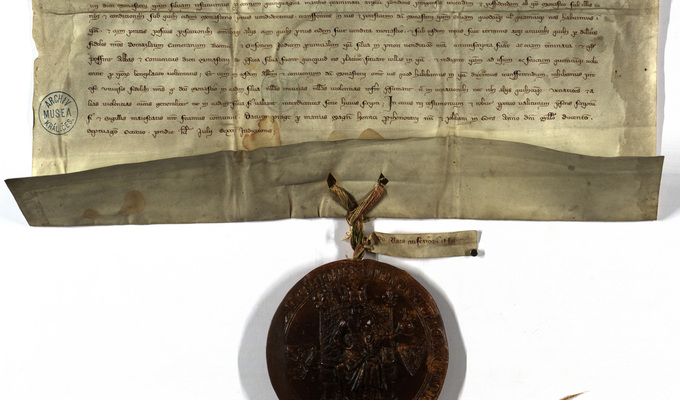The National Museum Archives manages extensive fonds and collections, which number almost 1000 and take up approximately 3,000 linear metres.
The "old collections”, which were started at the very birth of the National Museum, form the core of the archive. These are collections organized according to pertinence and include collections of parchments, genealogy and topography, patents, as well as collections of manuscripts, stamps, seals and heraldic signs. Eichler’s topographic collection and several heraldry and genealogy collections might also be included here. These collections are complete; only single acquisitions might exceptionally be added.
Currently, the main focus of the National Museum Archives is the acquisition of estates of significant figures of our cultural, political and scientific scenes. Practically the entire existence of the museum's archives is connected with this activity. The very first fonds of this kind was the family archive of the (acquired in 1830), and later some documents from the Palacký, Rieger and Bráfa families were added. This focus of acquisitions was further emphasised when the archive was headed by A. Chalupa. He gathered documents of notable figures associated with the National Museum, along with others, for example, numismatists (E. Fiala, E. Nohejlová-Prátová), anthropologists (J. Matiegka), historians (F. M. Bartoš, J. Pekař, J. Janáček) and natural scientists (J. Barrande, K. Domin). The estates of political figures of the first half of the 20th century (K. Kramář, A. Rašín, Z. Fierliger, E. Beneš) are much studied.
The documents related to the National Museum itself, i.e. its registry, make a separate section of the archives. It concerns the entire existence of our institution, from 1818 to the present. It is the most significant source for the history of the National Museum and also of all fields practised within it. The museum’s registry can also make a significant contribution to the understanding of the lives and works of many significant figures of science and research associated with the National Museum in the past.
The document and photograph collections on 19th and 20th century history, which have been gathered systematically since the 1930s, are used abundantly for research. From the many photographic collections, the Castle Photo Archives, the journalistic photo archive of the Práce and Národní politika dailies, and the photo archive of Karel Hájek, are particularly noteworthy. The document collections concern a number of important historical events, from 1848, through World War II to the second half of the 20th century. There are also the significant collections of various types of material, of which the collections of posters and postcards are the most extensive.

